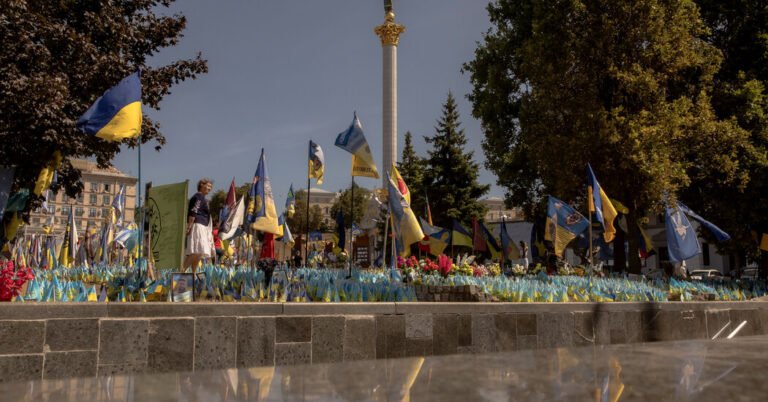
President Volodymyr Zelensky, always adept at messaging, used his latest Independence Day speech on Saturday to drive home the idea that Ukraine is taking the fight to Russia, even as his troops struggle along the front line in the east.
He said the video of the speech was filmed near the site where his troops began a cross-border offensive into Russian territory nearly three weeks ago that caught Moscow by surprise and yielded a bounty in Russian prisoners of war. That paid immediate dividends on Saturday when the two sides each sent 115 prisoners to the other in an exchange brokered by the United Arab Emirates.
Mr. Zelensky’s video was prerecorded from what he described as a location along the Psel River, an area frequently targeted by Russian artillery.
“Whoever wished misery upon our land shall find it in their own home,” Mr. Zelensky said of the incursion, which has pushed into the Kursk region of southwestern Russia.
He called his military’s operation — which has come after two and a half years of Russia’s brutal, all-out invasion of Ukraine — a “boomerang for evil.”
In the prisoner exchange, Ukraine said it had freed soldiers held in Russia since early in the invasion. That included dozens of soldiers who had held out for months in the siege of the Azovstal steel mill in Mariupol, before surrendering on the orders of Mr. Zelensky when escape or further resistance became hopeless.
Freeing some of the Azovstal prisoners eases domestic pressures on Mr. Zelensky, who has faced weekly protests from family members in Kyiv, Ukraine’s capital. However, hundreds more remain in captivity.
The trade also freed six national guard soldiers captured on the first day of the invasion in the irradiated zone around the crippled Chernobyl nuclear power plant, as Russian soldiers streamed into Ukraine through the nuclear disaster zone as the shortest route to Kyiv from the Belarusian border.
Russia’s human rights ombudsman, Tatyana Moskalkova, wrote on the Telegram social networking site that all of the Russians freed in the exchange were conscripts, and that most had been captured in Russia during Ukraine’s recent incursion.
The loss of conscripts, whether killed or captured, has stirred social unrest in earlier Russian wars in Afghanistan and Chechnya. Conscripts are drafted after high school on the promise that they will act in support roles but not be sent into active fighting.
“Though they were there for a short time, for us it seemed like eternity,” Ms. Moskalkova wrote of the conscripts captured in the incursion, which began on Aug. 6.
The Independence Day celebration on Saturday marks 33 years since Ukraine split away from a crumbling Soviet Union. Earlier in the war, Ukraine marked the day by parading burned Russian armored vehicles along Kyiv’s central thoroughfare, Khreshchatyk Street, using the holiday to bolster morale. This year, Mr. Zelensky hosted Poland’s president, Andrzej Duda, and Lithuania’s prime minister, Ingrida Simonyte, at ceremonies in Kyiv.
The Ukrainian counterattack into Russia that Mr. Zelensky celebrated this year has seized more than 490 square miles of territory and displaced tens of thousands of Russians, posing a domestic challenge for Moscow. But it has so far fallen short of a key goal: forcing Russia to divert troops from areas of fierce fighting in the Donbas region of eastern Ukraine, where Ukrainian troops have been losing ground.
At the same time, the Ukrainian operation is fraught with risks, relying on troops drawn from defensive positions in the Donbas, even as Russia closes in on the city of Pokrovsk, a road and rail hub. Analysts also question whether the Ukrainians can manage to hold onto the territory they have seized.
Undeterred by such obstacles, Ukraine has begun a far smaller offensive on another section of the front, this time inside Ukraine, in the Kharkiv region in the northwest, near the Russian border.
This offensive began on Thursday and has reclaimed a swath of land — less than a square mile, according to the Ukrainian military. The claim could not be independently verified.
The thrust in Kharkiv seized on an opportunity created when Russia moved a limited number of troops from neighboring areas in northern Ukraine to deal with the Kursk incursion, according to an analysis of publicly available information by the Institute for the Study of War, a Washington research group.
Ukraine has also stepped up long-range strikes with exploding drones and missiles in recent weeks, sinking a Russian ferry in the Black Sea that a Ukrainian navy spokesman said was part of a fuel supply network for Russian troops in the Donbas region. Ukraine also attacked a sprawling oil and aviation fuel tank farm in Russia’s Rostov region, setting a fire that was still burning on Saturday.
And the governor of Russia’s Voronezh region, south of Moscow, declared a state of emergency Saturday after a flurry of Ukrainian drone strikes set off explosions at a military storage site.
Also on Saturday, as part of a long-running feud, Mr. Zelensky signed a law that could enable a ban on a Russian-aligned branch of the Orthodox Church in Ukraine. Ukrainian officials have long said that the Russian Orthodox Church is little more than an extension of the Russian government, with priests used for espionage and to spread propaganda. With the Russian invasion, the issue has grown increasingly acute.
Under the law, a committee would assess whether churches have ties to the Russian state and therefore should be banned. The law has drawn criticism from the Russian-affiliated church in Ukraine as an infringement on freedom of religion.